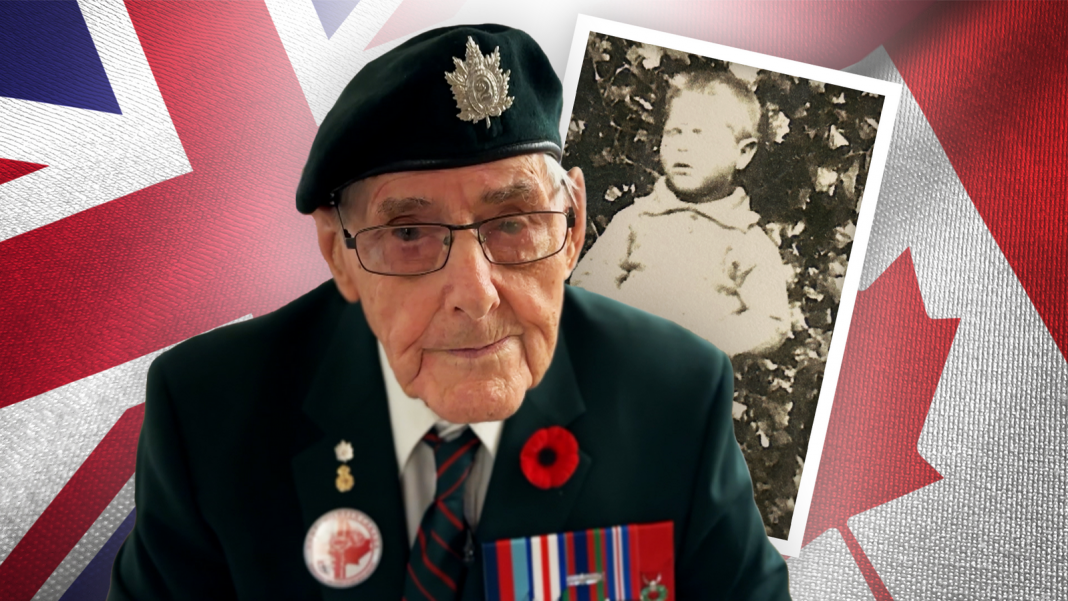“A lot of people thought we were the scum of the earth,” he says of the Canada he encountered upon arrival as a teenager in 1938.
George Beardshaw is immaculate in pressed Canadian military green, beret and blazer. On his lapel, a strip of medals is anchored by the French Legion of Honour, for action during World War II.
George’s appearance and his past speak to the service this Yorkshire-born veteran gave to Canada, a country he grew to love. It would love him back, in time, after a difficult start.
George saw service in France during the Second World War
George was one of 115,000 so-called British Home Children transported from orphan homes to Canada between 1869 and 1948. They were used as cheap labour, typically farm workers and domestic servants.
Their stories of being routinely overworked, mistreated and abused have been well-documented over the years. Many died young and suspicions persist that some were murdered.
Campaigners for the Home Children have demanded that Canada follow the UK and Australia in apologising for their involvement in child migrant schemes. When asked by Sky News if his government owed them an apology, Canadian Prime Minister Justin Trudeau didn’t address the question, saying only: “Good to see you.”
Today, George Beardshaw is one of the last surviving Home Children in Canada. The fighting days of an old soldier might be far behind him but this centenarian doesn’t shy away from the struggle to hear the word “sorry” from his adoptive country.
Asked if Justin Trudeau owed the Home Children an apology, he replied: “Yes, I think so. Yes.”
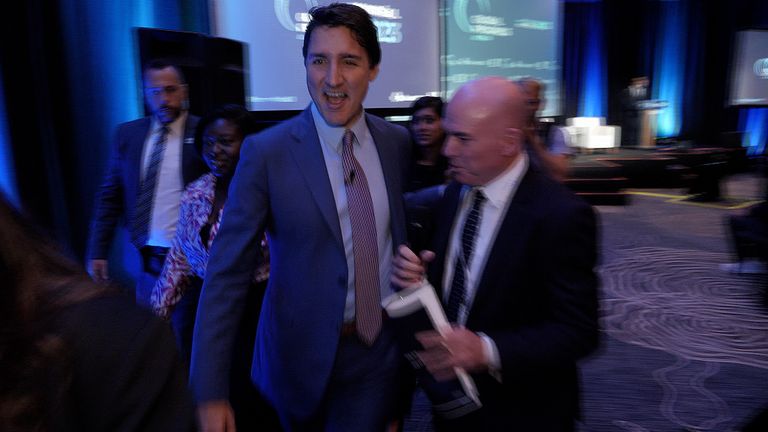
Sky News asked Canadian PM Justin Trudeau: ‘Does your government owe an apology?’
George was born in Thorne, South Yorkshire, in 1923. His mother sent him to live in a Barnardo’s home when he was a small child and he was shipped to Canada when he was 14 and put to work as a farmhand.
He told Sky News: “People thought that Britain was sending over some of the scum from off the streets of London, they all thought we were thieves.”
“Some got pitchforks through them. Some slept in the barn with the cattle.
“There was a furnace in this house (where I lived) to keep it warm, you know, down in the basement. But there was no heat on my side, where my bedroom was, and it used to get pretty chilly.”
Many British Home Children, when they were old enough, enlisted in the military to be sent back across the Atlantic and reunited with their families.
George joined the Second World War effort and was posted, temporarily, to the UK.
He told Sky News of the day he walked back into the family home in Yorkshire, for the first time since he was a small child, wearing the uniform of Canada’s Queen’s Own Rifles.
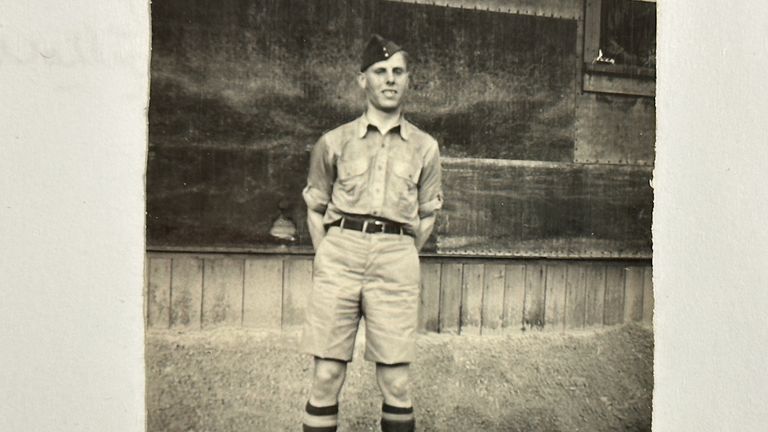
George in Canadian military uniform. He served with the Queen’s Own Rifles.
“Can you imagine? ‘Georgie Porgey’, here he is – 20 years old, knocking on [my mother’s] front door. She didn’t know I was coming and she’d not seen me since I was three. When I went inside, people didn’t know what to say or do, you know, ‘Here he is, George from Canada’.”
He continued: “My grandmother was sitting in a big easy chair. As I walked by, she grabbed me by my webbing belt, sat me on her knee and she rubbed her face up against mine.”
Today, roughly 10% of Canada’s population is descended from the British Home Children. In a corner of Toronto’s Park Lawn cemetery, a memorial stands to more than 70 children whose remains have been discovered, in recent years, in unmarked graves.
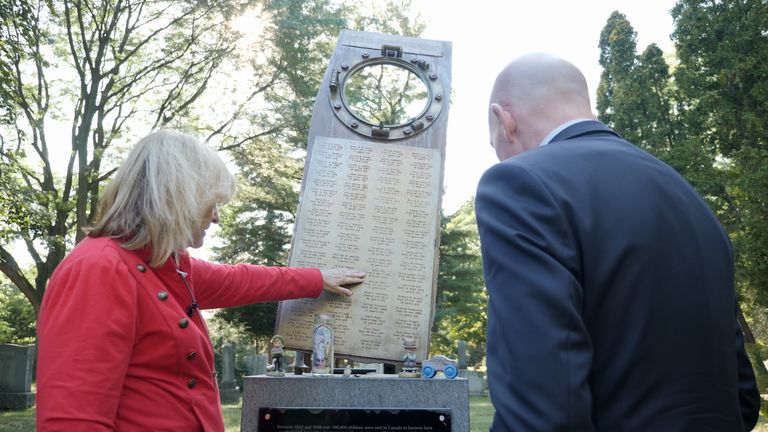
A memorial to British Home Children at Toronto’s Park Lawn cemetery
The memorial consists of a block of granite with a piece of plate steel – complete with porthole – taken from a ship in the style of the vessels that transported children to Canada. Carved into the steel are the names of youngsters who died.
It was commissioned by the charity, Home Children Canada, which works to preserve the memory of the Home Children and to reunite families separated by child migrant schemes. It has led the campaign for an apology by the Canadian government.
The charity’s founder, Lori Oschefski, told Sky News: “This country was built on the backs of these children. It’s just a travesty. They knew about the horrific treatment.
“A lot of these kids were stripped of their identities. They were taken from their parents and they never saw their families ever again. And a lot of them were not even told about who they were and where they had come from.
“It’s human trafficking. It’s a violation of their fundamental human rights. They were put out on farms and … were often made to sleep in barns and unheated attics to stay far away from the families.
“Typically, for a young boy, they would be woken up at daybreak and work until nightfall. A lot of them were fed scraps of food. And when they showed any defiance, if we can call it defiance, they were beaten.”
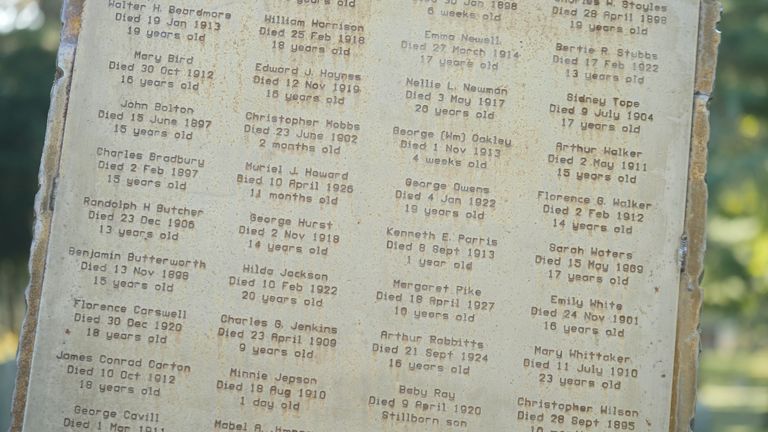
The memorial lists the names of more than 70 children.
Home Children Canada has also called on Canadian authorities to include the history of Home Children in the educational curriculum and to honour youngsters who fought for Canada at war.
At the heart of its campaigning, however, is the demand for a formal apology.
“We’re looking for an apology from the government of Canada and one of the primary reasons is because Canada failed these children. They had a hand in in bringing them here. They paid money to the sending organisations to have them here in Canada,” Ms Oschefski added.
“Why wouldn’t you apologise, especially when there are other countries stepping up to the plate and and apologising and becoming accountable for what happened? We’re not looking for compensation in the form of money. What we’re looking for is proper recognition for the Home Children.”
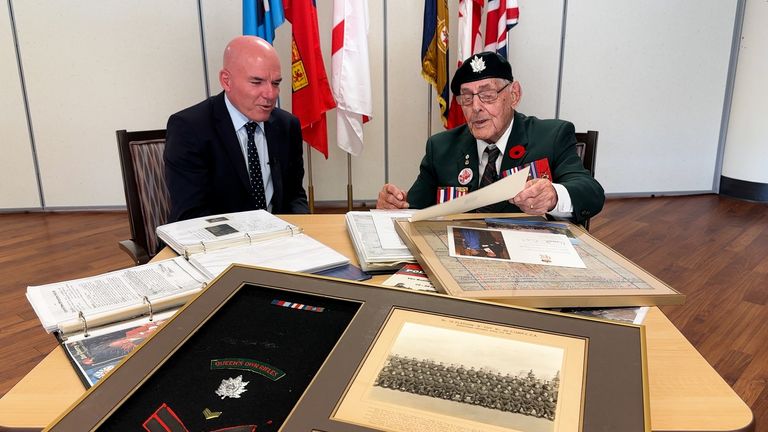
George shows James Matthews his birthday messages from the King and Queen, and Canadian Prime Minister Justin Trudeau
In 2010, the then UK prime minister Gordon Brown apologised for those involved in child migrant schemes to former British colonies. The year before, former Australian prime minister Kevin Rudd offered a formal apology for its role.
In 2017, Canada’s parliamentarians passed a motion of apology for the treatment of Home Children, but a formal apology hasn’t been forthcoming from the government itself.
The Canadian government did issue a statement to Sky News, which spoke of regret but didn’t say sorry. It read: “The government of Canada is committed to keeping the memory of the British Home Children alive so that we can all learn from past mistakes.
“Immigration, Refugees and Citizenship Canada deeply regrets this unjust and discriminatory policy, which was in place between 1869 to 1948. Such an approach would have no place in modern Canada, but we will not pretend that this did not happen.
“In 2017, a motion was passed in the House of Commons, by unanimous consent, to offer its sincere apology to the former British Home Children and to the descendants of these 100,000 individuals.
“The government acknowledges the injustice, abuse and suffering endured by the British Home Children, and thanks them sincerely for their remarkable efforts, participation and contribution to strengthening our communities and our country in the face of extreme adversity.”
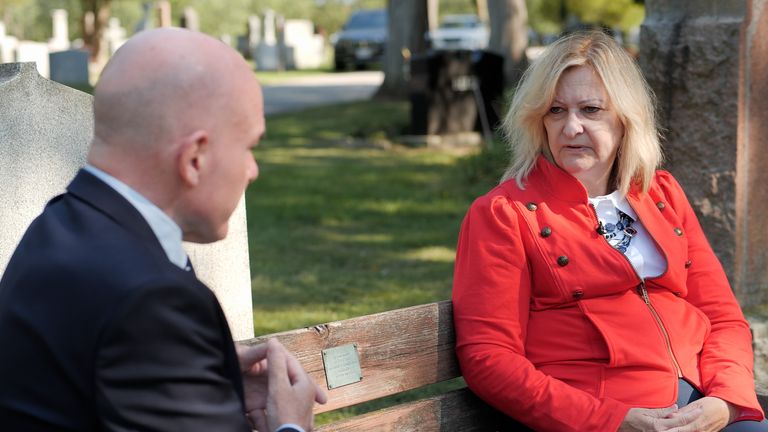
Lori Oschefski founded the charity Home Children Canada
Back at the Parkwood Institute in London, Ontario, George Beardshaw was celebrating his 100th birthday. We joined him as he assembled friends and fellow veterans.
“If things improve with age, I’m getting pretty near perfect,” read the legend on his T-shirt and no-one was arguing – his friends and fellow veterans are familiar with, and fond of, the legend inside.
“All my buddies are in here,” George told us, and he was duly serenaded with his favourite song, The White Cliffs of Dover. The Vera Lynn classic was sung by Grace, who happened to be a Patsy Cline impersonator. It was a mild incongruity but this was George’s party and it was what he wanted to hear.
At the age of 100, he still waits to hear the word “sorry” – officially. The hardest word comes with a hard reality. He can’t wait forever.


